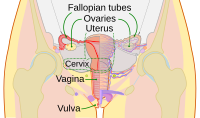
Photo from wikipedia
Abstract Purpose Evaluate a cone‐beam computed tomography (CBCT)‐based daily adaptive platform in cervical cancer for multiple endpoints: (1) physics contouring accuracy of daily CTVs, (2) CTV coverage with adapted plans… Click to show full abstract
Abstract Purpose Evaluate a cone‐beam computed tomography (CBCT)‐based daily adaptive platform in cervical cancer for multiple endpoints: (1) physics contouring accuracy of daily CTVs, (2) CTV coverage with adapted plans and reduced PTV margins versus non‐adapted plans with standard‐of‐care (SOC) margins, (3) dosimetric improvements to CTV and organs‐at‐risk (OARs), and (4) on‐couch time. Methods and materials Using a Varian Ethos™ emulator and KV‐CBCT scans, we simulated the doses 15 retrospective cervical cancer patients would have received with/without online adaptation for five fractions. We compared contours and doses from SOC plans (5–15 mm CTV‐to‐PTV margins) to adapted plans (3 mm margins). Auto‐segmented CTVs and OARs were reviewed and edited by trained physicists. Physics‐edited targets were evaluated by an oncologist. Time spent reviewing and editing auto‐segmented structures was recorded. Metrics from the CTV (D99%), bowel (V45Gy, V40Gy), bladder (D50%), and rectum (D50%) were compared. Results The physician approved the physics‐edited CTVs for 55/75 fractions; 16/75 required reductions, and 4/75 required CTV expansions. CTVs were encapsulated by unadapted, SOC PTVs for 56/75 (72%) fractions—representative of current clinical practice. CTVs were completely covered by adapted 3 mm PTVs for 71/75 (94.6%) fractions. CTV D99% values for adapted plans were comparable to non‐adapted SOC plans (average difference of −0.9%), while all OAR metrics improved with adaptation. Specifically, bowel V45Gy and V40Gy decreased on average by 87.6 and 109.4 cc, while bladder and rectum D50% decreased by 37.7% and 35.8%, respectively. The time required for contouring and calculating an adaptive plan for 65/75 fractions was less than 20 min (range: 1–29 min). Conclusions Improved dose metrics with daily adaption could translate to reduced toxicity while maintaining tumor control. Training physicists to perform contouring edits could minimize the time physicians are required at adaptive sessions improving clinical efficiency. All emulated adaptive sessions were completed within 30 min however extra time will be required for patient setup, image acquisition, and treatment delivery.
Journal Title: Journal of Applied Clinical Medical Physics
Year Published: 2022
Link to full text (if available)
Share on Social Media: Sign Up to like & get
recommendations!